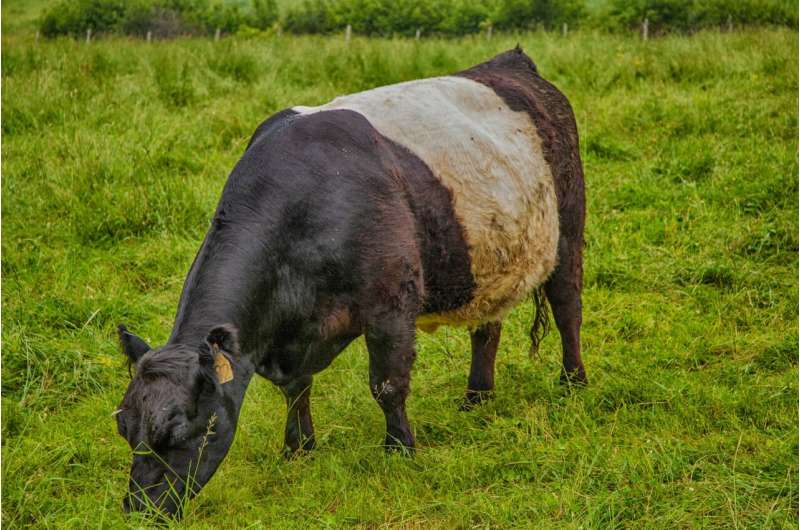This article has been reviewed according to Science X's editorial process and policies. Editors have highlighted the following attributes while ensuring the content's credibility:
fact-checked
trusted source
proofread
Small adjustments can reduce nitrogen loss in peat meadows, says researcher

Relatively simple adjustments can reduce nitrogen losses on dairy farms in peatland areas. That's the conclusion of the Ph.D. research by Leiden environmental scientist Jeroen Pijlman at the Louis Bolk Institute. Protein-poor grass species and narrow-leaved plantain in the grassland can limit nitrogen loss without decreasing milk yield. The research also demonstrates potential for the wet cultivation of bulrush.
The agricultural sector faces the significant challenge of further reducing nitrogen emissions. Peat soils, primarily consisting of grassland for dairy farming, pose a complicating factor due to peat decomposition. This not only causes soil subsidence and greenhouse gas emissions but also contributes to significant nitrogen losses in peatland areas. On average, an estimated 210 kg of nitrogen per hectare is lost annually through the air and water.
Pijlman wanted to determine if simple adjustments such as reducing fertilizer use and using different grass species and crops like narrow-leaved plantain could improve the nitrogen cycle. "It can never be fully closed, but I wanted to see if we could at least partially close the nitrogen tap," he says.
Reducing fertilizer through good timing
The soil contains a large stock of nitrogen, some of which is lost through the air and water. Farmers replenish this annually with (artificial) fertilizers. Pijlman wanted to know if existing stocks could be used more efficiently. In spring, the soil lacks nitrogen, but from summer onwards, there is sufficient nitrogen available for grass.
Pijlman's research shows that by capitalizing on this, less fertilizer is needed, and nitrogen losses can be reduced. While this may seem obvious, Pijlman notes that farmers are cautious about reducing fertilization. "Running a farm also involves risk management, so farmers prefer to stay on the safe side. This approach also requires some calculations, and not everyone appreciates that."
Less nitrogen loss with a different grass species
Due to the high groundwater levels, the peat meadow area is predominantly grassland. The current grass species contain relatively high protein levels, resulting in manure with a high nitrogen content. Through water and air, a significant amount of nitrogen is lost from this nitrogen-rich manure: it is lost from the system.
But what if you cultivate a less protein-rich grass, reasoned Pijlman. "Therefore, we used an English ryegrass which shows a lower protein content on sandy soils. On peat soil, this resulted in up to 4% less protein in the grass. Also, the nitrogen content in the manure decreases by about 4%, which is quite a significant step."
Significant reduction in nitrous oxide emissions through narrow-leaved plantain
The sowing of narrow-leaved plantain between the grass also yielded a positive effect: it resulted in approximately 37% less nitrous oxide (N2O) emissions, a significant greenhouse gas. The results exceeded all expectations. Pijlman says, "We knew that plantain could inhibit nitrate breakdown and tolerate drought better than grass. However, we did not expect this to hold true even in nitrogen-rich conditions."
According to the researcher, this also holds potential for other soil types. However, he adds a caveat, "It's a challenge to maintain plantain within the grass mat, as it often disappears within a few years."
Bulrush is also a solution (and good lining for your jacket)
Pijlman also investigated a more radical change: cultivating bulrush on peat soil. Bulrush can replace up to 5% of cows' roughage, but it can also be used (more lucratively) as insulation material. Bulrush is particularly interesting for plots too wet for grass but where water levels cannot or should not be lowered further.
Additionally, this significantly slows down peat decomposition and soil subsidence. "The nutritional value of bulrush is lower, but other business models are possible," says Pijlman. "In England, they are exploring whether bulrush fluff could be used as an alternative lining for jackets."
'Combine measures and establish norms per hectare'
The entire Dutch agricultural sector must reduce ammonia (NH3) emissions by 50% by 2035 (based on the Dutch nitrogen law). By combining Pijlman's ideas, a reduction of around 7% can be achieved at the farm level. According to the Ph.D. candidate, combining these measures with others could make a significant difference, but farmers currently lack clarity on their position.
"It's very difficult to translate the sectoral challenge to the farm level. Additionally, the nitrogen challenge varies by area, and if the livestock decreases, other businesses get more leeway. Establishing a norm per hectare and providing guidance on which measures are effective would greatly assist farmers."
Provided by Leiden University





















